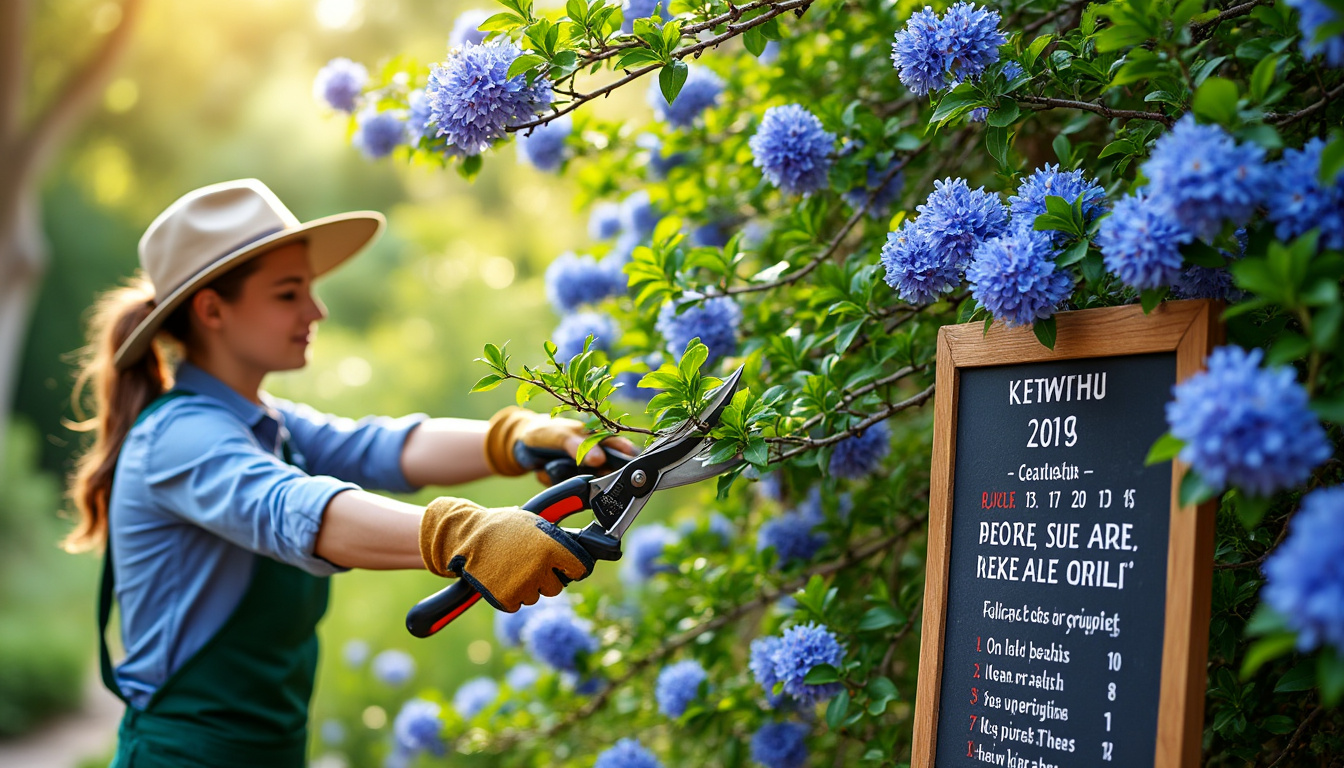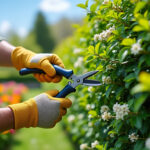Understanding the timing and techniques for pruning ceanothus, commonly known as California lilac, is vital for ensuring optimal growth and maintaining its beauty. This versatile shrub can bring charm to any garden, thriving when managed correctly. Various factors influence the best time to prune, particularly whether the variety is evergreen or deciduous. This article will explore the nuances of ceanothus pruning, providing detailed insights into the best practices to adopt for different types.
When to Prune the Ceanothus Tree?
The timing of pruning is crucial for the health and shape of the ceanothus tree. There exist two primary categories: evergreen and deciduous varieties, each requiring a specific approach regarding when to prune.
Pruning Evergreen Ceanothus
Evergreen ceanothus, such as Ceanothus Concha, should be pruned after flowering, typically from late spring to late summer. This timing allows the plant to spend its blooming energy before cutting back. By trimming after the flowers have faded, new growth can be encouraged, thus maintaining both the health and aesthetic harmony of the shrub.
When cutting back, focus on:
- Removing faded inflorescences 🌼
- Eliminating dead or diseased wood 🪵
- Shaping the overall tree structure while maintaining an open, airy form 🍃
Pruning Deciduous Ceanothus
In contrast, deciduous varieties like Ceanothus Americanus require attention before they begin blooming, specifically at the end of winter. Ideal pruning should be performed just as the plant comes out of dormancy.
Key steps for pruning deciduous ceanothus include:
- Trimming back young shoots above the third bud to encourage bushier growth 🌱
- Removing any dead or crossing branches for better airflow 🌬️
- Ensuring that the natural shape is respected to avoid overly aggressive cutting 🔪
| Type of Ceanothus | Best Time to Prune | Key Practices |
|---|---|---|
| Evergreen (e.g., Ceanothus Concha) | After flowering (Late Spring to Late Summer) | Remove faded flowers, dead wood, shape lightly |
| Deciduous (e.g., Ceanothus Americanus) | Before flowering (End of Winter) | Trim young shoots, remove dead branches, shape lightly |
How to Prune a Ceanothus?
Effective pruning methods for ceanothus depend significantly on the type of shrub in question. It is essential to adopt techniques that best suit the growth patterns of the particular variety.
Light Pruning for Evergreen Varieties
For evergreen ceanothus, less drastic approaches to pruning are encouraged. The primary focus should involve:
- Removal of spent flowers 🌸
- Trimming back any weak or old wood to facilitate new growth 🌿
- Encouraging an open structure to promote sunlight penetration ☀️
The method consists of cutting back just enough to maintain its shape while allowing light to reach the center. This promotes a healthy balance of new and established growth.
Rejuvenation Pruning for Deciduous Varieties
For older deciduous ceanothus, rejuvenation pruning can be beneficial. This involves a more thorough approach and includes:
- Cutting young shoots back to encourage denser foliage 🍃
- Trimming branches that are poorly placed or cross over one another to prevent choking 🌲
- Removing any deadwood to invigorate the growth cycle 🌱
This method can help revive an aging plant and extend its lifespan, ensuring vibrant blooming seasons in the years to come.
| Type of Pruning | Focus Areas | Expected Outcome |
|---|---|---|
| Light Pruning (Evergreen) | Faded flowers, dead wood, shaping | Maintains structure, encourages sunlight |
| Rejuvenation Pruning (Deciduous) | Young shoots, crossing branches, deadwood | Stimulates new growth, enhances blooming |
When to prune pyracantha for optimal growth?
Why Prune Your Ceanothus? What Are the Main Advantages?
Knowing the benefits of pruning can motivate gardeners to adopt these practices for their ceanothus trees. Below are several advantages of regular pruning:
- Promotes New Growth: Pruning removes old, ineffective growth, allowing the plant to channel energy into creating fresh leaves and blooms 🌼.
- Improves Shape: Correct pruning techniques maintain an appealing shape, keeping the plant from becoming too invasive ⚖️.
- Prevents Diseases: Regular removals of damaged branches can inhibit disease spread, protecting the overall tree health 🚫.
- Boosts Spring Flowering: Well-timed pruning leads to increased flowers in the following spring, ensuring the plant continues to provide beauty 🌸.
In combination, these benefits lend themselves to an enhanced aesthetic appeal and plant vitality, making pruning a crucial horticultural task.
| Benefit of Pruning | Description | Example Outcome |
|---|---|---|
| Promotes New Growth | Encourages fresh foliage and blooms | Flourishing spring flowers |
| Improves Shape | Maintains well-proportioned structure | Balanced garden aesthetic |
| Prevents Diseases | Reduces risk by removing weak branches | Healthy, disease-free environment |
| Boosts Spring Flowering | More blossoms arise from effective cuts | Vibrant blooms annually |
Additional Maintenance Tips
Emphasizing proper pruning techniques lays a strong foundation for the ceanothus’s health, but additional maintenance measures enhance this care further.
Using Proper Tools
It is essential to utilize clean, sharp instruments for pruning tasks. Sharp tools guarantee clean cuts that lower the risk of infection. Inadequate tools can result in jagged cuts, inviting disease into the plant.
Timing and Weather Considerations
Avoid rainy or overly humid conditions during pruning seasons, as wet weather can result in disease spread. Pruning in dry weather helps mitigate fungal infections and promotes healthier plant maintenance.
Respecting Natural Shape
Ceanothus do not respond well to drastic reshaping. As such, gardening practices should focus on preserving the plant’s natural look while ensuring that only necessary branches are pruned.
| Maintenance Tip | Details | Expected Outcome |
|---|---|---|
| Use Clean Tools | Maintain sharpness and cleanliness to promote health | Reducing disease risk |
| Avoid Wet Weather | Limit fungal threats during rainy conditions | Healthier plant structure |
| Respect Natural Shape | Aim for gentle shaping rather than aggressive cuts | Aesthetic appeal and longevity |
FAQ
Q: When is the best time to prune evergreen ceanothus?
A: The ideal time for pruning evergreen ceanothus is after flowering, typically in late spring to late summer.
Q: How do I prune deciduous ceanothus, and when?
A: Pruning of deciduous ceanothus should take place at the end of winter, focusing on cutting back young shoots above the third bud.
Q: Why is pruning important for ceanothus?
A: Regular pruning promotes new growth, improves the shape, prevents diseases, and enhances spring flowering.
Q: What tools should be used for pruning?
A: Clean, sharp pruning shears and loppers are recommended for making precise cuts that minimize damage to the plant.
Q: Can I prune ceanothus in wet weather?
A: It is best to avoid pruning during wet conditions as this may increase the risk of fungal infections and disease spread.















